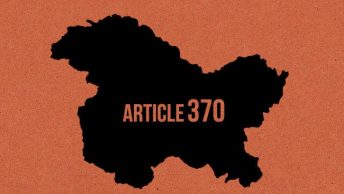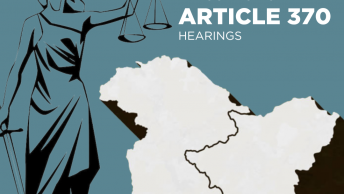With the aim of enabling our readers to keep up with the Supreme Court of India’s day-to-day hearings for the significant case concerning the abrogation of Article 370, LAOT, in collaboration with the Centre for Constitutional Law, NALSAR is bringing you a concise daily summary of what was argued in the Court. This is an introductory piece by Prof. (Dr.) Vasanthi Nimushakavi, who is the head of the Centre.
The Supreme Court of India (“SC”) will start hearing petitions on the abrogation of Article 370 precisely three days before the completion of four years of the announcement of the arbogation of the article, the re-organisation of the State of Jammu and Kashmir (“J&K”) into Union Territories (“UT”) and the suspension of its legislative assembly.
The petitions seek to reverse the actions of amending the Constitution through executive action, passing a Reorganisation Act without the consultation of the state assembly, and suspending the legislative assembly for an indefinite period. These issues form six limbs in the arguments presented in this case: the Reorganisation Act, the question of reorganisation of states in India and the requirement for state consultation, the abrogation of a special provision, the ability to amend the Constitution through executive orders, and expanding on asymmetric federalism in India.
The J&K Reorganisation Act
The J&K Reorganisation Act does more than just reorganise the state. It amends the First Schedule of the Indian Constitution deleting the entry of J&K as a state and adding the two UTs of J&K and Ladakh to the list of Union Territories. The Act also provided for representation in the Parliament from the UTs. The Act has detailed provisions on legislative competence of the legislative assembly and extends the doctrine of repugnancy as contained in Article 254 to the UTs. This in a sense is extending the constitutional provisions through legislation which is not required as the Constitution is now deemed to extend to the UTs , in the absence of Article 370. It also extends provisions of the Constitution such as the power to make ordinances, a power exercised by the Governor of a state, to the Lieutenant Governor of J&K. The Act also has provisions on the delimitation of constituencies and increasing the number of seats in the legislative assembly of J&K.
The Act is symbolic of the approach taken towards the state, where, through executive order, provisions of the Constitution were extended. Since the introduction of Article 370, several constitutional orders have been passed by the President, which in effect have weakened the promise of independence that Article 370 is premised upon.
It also provides that in case of a situation where the administration of the UT of J&K cannot be carried out in accordance with the provisions of this Reorganisation Act, the President may suspend the operation of all or any of the provisions of this Act for such period as he thinks fit. In short, an Act that provides for its suspension through executive fiat and without the constitutional protections that a legislature would normally enjoy under the Constitution. The challenge to this Act would proceed not only on fundamental rights but also on whether this is legislation that touches upon the basic structure of the Constitution.
Consultation and Reorganisation of States
The second limb is the position on reorganisation of states in India. In the history of reorganisation of states in India, there has never been an occasion where the Union has acted unilaterally to bifurcate a state. The demand for statehood has always come from regional movements. The Court could very well uphold the Reorganisation Act on the basis of a textual reading of Article 3 which confers absolute power on the Union Parliament and has been defended on a normative and functional basis in earlier instances. These have also relied on the Parliament being more suitable to bring about a law in this regard, especially in light of sub-regional disparities and conflicts.
Precedents in this area have not focussed enough on the democratic principles that were violated. The literature beyond precedents has pointed to the significance of the term “Union of States”, the deeply embedded federal principles, and the significance of democracy and human rights. The legal aspects, such as the significance of the expression of views by the state assembly, and the need to read the Constitution as an integral whole rather than in silos, would need to be decided. It might need to overrule earlier precedents such as Babulal Parate v. State of Bombay (1960), which declined to invoke the need for a democratic process to precede state formation. It might also re-consider the wide powers given to the Parliament in light of the theory of federalism which has been built over the decades since the S.R. Bommai judgment
Special and Temporary Provisions: Article 370
The third limb of the litigation is the nature of special and temporary provisions in the Constitution. The Indian Constitution contains many provisions which are specific to geographical and other identities. The Fifth and Sixth schedule speak to both geographical as well as cultural identities. The provisions with reference to backward areas in several states refer to the imbalanced development in the country. Article 370 is one of the many provisions providing for temporary and special measures in the constitution. These measures have a bearing on the federal question by identifying regional-specific needs and understanding Indian federalism as respecting diverse needs and mechanisms to address these. The amendment of the Constitution which impacts federalism would require a special majority under Article 368, if clause (2) is read in a purposive manner.
Constitutional Amendments through Executive Order
There has not been an earlier occasion to amend the Constitution through Presidential Notification as was done through C.O.272 which modified Article 367 of the Constitution to change the meaning of the term “constituent assembly” to mean “legislature of state” and C.O. 273, which declared that Article 370 ceased to be operative. The jurisprudence of constitutional orders requires a rigorous review.
It could rely on principles such as a fraud on the Constitution that have been set out with reference to executive action that interferes with legislative power and constitutional amendments through executive action.
Asymmetric Federalism
A related aspect of the re-organisation of State is that of asymmetric federalism. This could be an occasion for the court to reject its overreliance on the Nation-State theory of federalism and finally set aside its hesitancy in accepting the unique character of Indian federalism. In decisions like Mohit Minerals, where the SC held that India recognizes a dual federalism, we have seen the possibility of building a theory of federalism for India that best explains the interdependence of State and Central Governments that the Indian Constitution sets out, which is unlike any other constitution in the world.
The Court could invoke the principle of federalism such as participation, accommodation, unity and not only a union of states. In several decisions, the Court has come to accept diversity as an integral part of Indian Federalism. The diverse mechanisms that the Indian Constitution stipulates to respect and promote democracy include special provisions. These could be with respect to geographical territories or specific groups. The mixed bag of rulings on Art. 370 which have been given out in different contexts would benefit from a revisiting. The different approach taken by the SC in cases of special provisions in other parts of the country, such as provisions of Articles 371 A to J, or the Fifth and Sixth schedules need to be harmonised with the provisions of Article 370.
Concluding Remarks
The SC is rightly understood as the most powerful court in the world. It has claimed the power to restore state governments that have been dismissed in violation of the principles of the Constitution. It has claimed the power to hold unconstitutional laws to be void ab initio if they are in derogation of fundamental rights. It has sought accountability from the highest constitutional offices. This decision could very well be the equivalent of the Bommai judgment, which has changed politics decisively, for decades to come.
Vasanthi Nimushakavi is a Professor of Constitutional Law at NALSAR University of Law, Hyderabad. She heads the Centre for Constitutional Law, Public Policy and Good Governance.
This collaboration was coordinated by Avani Vijay, edited by Archita Satish and published by Harshitha Adari from our Student Editorial Team.






[…] Posted byVasanthi Nimushakavi […]